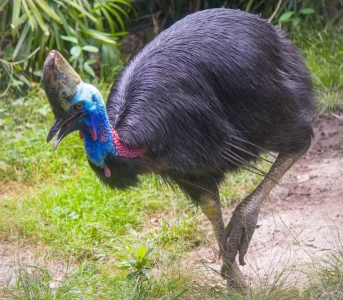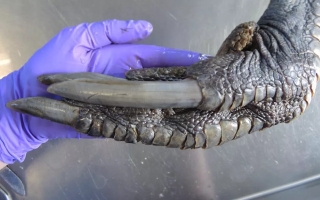  The cassowary is a large, flightless bird, standing between 1.5 and 2 metres in height. The cassowary is the heaviest bird in Australia, and the second heaviest in the world after the ostrich. It's covered in dense black feathers that, from a distance, look like hair. All three cassowary species have a helmet that starts to develop on top of their head at one to two years of age. It's made of a spongy material and covered with a thick layer of keratin, the same thing fingernails are made of.
The cassowary is a large, flightless bird, standing between 1.5 and 2 metres in height. The cassowary is the heaviest bird in Australia, and the second heaviest in the world after the ostrich. It's covered in dense black feathers that, from a distance, look like hair. All three cassowary species have a helmet that starts to develop on top of their head at one to two years of age. It's made of a spongy material and covered with a thick layer of keratin, the same thing fingernails are made of. They range across Northern Australia, New Guinea, and the surrounding islands. They live in tropical forests and wetlands. Cassowaries feed on the fruits of several hundred rainforest plants. They hiss and whistle to communicate, and clap their bills or rumble when making a threat. The rumble is so low and powerful that wildlife specialists working with the birds report they can feel it in their bones. Cassowaries are difficult to observe and study, as they are quick to hide in the thick rainforest, so little is known about their behaviour. They seem to be most active at dawn and dusk, when they search for food.  The cassowary is considered the most dangerous bird in the world. Each 3-toed foot has a dagger-like claw on the inner toe that is up to 10 centimeters long. The cassowary can slice open any predator or potential threat with a single swift kick, and has killed humans. Powerful legs help it run up to 50 kilometres per hour through the dense forest. A cassowary can also jump nearly 2 meters straight up into the air, and it's an excellent swimmer. The long claw also comes in handy when digging for fallen fruit.
The cassowary is considered the most dangerous bird in the world. Each 3-toed foot has a dagger-like claw on the inner toe that is up to 10 centimeters long. The cassowary can slice open any predator or potential threat with a single swift kick, and has killed humans. Powerful legs help it run up to 50 kilometres per hour through the dense forest. A cassowary can also jump nearly 2 meters straight up into the air, and it's an excellent swimmer. The long claw also comes in handy when digging for fallen fruit.
Although they are fruit eaters and will not attack randomly, they are very territorial. Most attacks on humans – resulting in people being kicked, pushed, pecked, charged at, jumped on and head butted – are due to the human trying to feed the bird. Despite been classified as the ‘most dangerous bird on Earth’, the last recorded death was in 1926. A male sits on a nest to incubate the eggs laid by the female, for up to 60 days. Once the brown-and-tan striped chicks hatch, he protects them and teaches them about how to find food. The young offspring stay with their father for 10 months or more. By this time, they are almost adult size and can take care of themselves. |